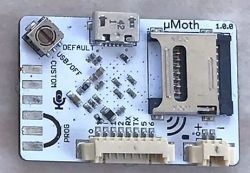Monitoring environmental sounds is perhaps not a common task, but much like with wildlife cameras, we could learn a lot from an always-on device listening in on Mother Nature. The AudioMoth is one of such devices. Although it has been around for a few years, it is notable for being an open platform, with the full Eagle-based hardware design files, BOM and firmware available, as well as NodeJS- and Electron-based utility software.
The AudioMoth is powered by a Silicon Labs EFM32-based MCU (EFM32WG980F256) with a Cortex-M4 core, 256 kB of Flash and 32 kB of SRAM. Using the onboard MEMS microphone it records both audible and ultrasonic frequencies that are written in uncompressed WAV format to the SD card. This makes it capable of capturing the sounds from bats in an area in addition to the calls of birds and other wildlife.
 The AudioMoth has also a micro-sized, low-cost version called the μMoth, which shares the same features as the AudioMoth. This project is still in progress, with updates expected later this year.
The AudioMoth has also a micro-sized, low-cost version called the μMoth, which shares the same features as the AudioMoth. This project is still in progress, with updates expected later this year.
Although the AudioMoth device can apparently be bought from sites like LabMaker for $74 at this point, it should be noted that the MCU used on the device is listed as ‘NRND’ (not recommended for new designs) by SiLabs, which may complicate building one in a number of years from now. Or at least you’ll have to substitute in a different microcontroller.
Regardless, it does seem like an interesting starting point for wildlife monitoring, whether one simply wants to build a device like this, or to use it as inspiration for one’s own design.















#1 PCB design pet peeve. Tent those vias.
https://hackaday.io/project/27257-fritzing-tricks/log/148636-tented-vias
Looks like the other photo they have of the thing shows tented vias, maybe the picture in the tree was a prototype:
https://static.wixstatic.com/media/b31671_5847b41dc0de4c8893a7ee370b433af8~mv2_d_2182_1886_s_2.png/v1/fill/w_291,h_240,al_c,q_85,usm_0.66_1.00_0.01/AM1-1.webp
The second picture shows silkscreen only tenting. It looks better. The gold standard is soldermask + silkscreen over the vias. It completely hides them.
I agree that the basic AudioMoth is a bit exposed but is is designed to live in a plastic bag when in use (plastic freezer bag with an Ikea plastic clip – when not in use mine lives in an old anti-static bag). I have the green original version, the pale blue photo is apparently the newer microMoth. The device is definitely a research tool designed to be set-up for a measurement program, tied to a tree or whatever and left. It is a nice little recorder but it has no buttons, no earphone socket, no external microphone socket, no recording level meter etc etc.
I use a spectroscope program to quickly analyse a recording (Linux Spek or Sox) because listening to the whole of a nights records can get tedious. So far I have as many mouse recordings as bat recordings.
I will soon be trying out a combination of small microphone (for ultrasonic response) feeding an SDRplay RSP1A wideband RF receiver which reputably goes down to 10kHz. I can’t really believe I will get it to work but one can but try.
I was interested in looking into ultrasonic wildlife detection, by the ultrasonics produced by brush and grass rustling. However, just put ultrasonics and wildlife or animal or whatever together and google won’t let me get past the bat detectors. (God I miss the old advanced operators and drill down tools). So just wondering if you’ve ventured into that at all and could give me a sprinkle of keywords to get me going.
Yeah, I found a lot about bats and mice but not much else. Look up AudioMoth** and you will get a wider range of info. My advice is to just try as many ways of recording as possible, some will work. My guess is that you will need to fashion a clip with a 1/4″ tripod socket so you can position the recorder mike close to what you want to record (air is apparently a bit murky for ultrasonics) and the AudioMoth is not the most low-noise recorder.
Here in Europe it definitely must have a waterproof housing or bag because of dew if not rain. Some birds have a peck at it also (around dawn for me).
Trail cameras seem to use mostly IR movement detection and some use ultrasonic distance detection.
** other ultrasonic recorders are also available
GroupGets have a group buy finishing on Wed, 01 Jul 2020 13:00:00 PDT $49.99 plus shipping.
Perfect companion for this sound recognition software!
http://soundid.net/
I wish I was rich. The AudioMoth has been used in wide area surveys needing lots of recorders and seems to have been built with that in mind. It costs a lot less than other ultrasonic recorders.
Similarly, on the not so expensive side of things, there are free access curated archives of birdsong etc for helping in identifying an unusual sound.
Baudline would be a free alternative for signal analysis.
Thanks. I hadn’t heard of Baudline. That’s going on my home computer today.
SoundID is a little different. Mainly recognition of sounds and less about measurement. It was actually developed for use in field studies of birds. Since then they’ve used it to recognize structural defects in steel, machinery issues and abnormal sounds of heart defects.
Infrasound recording might be good.